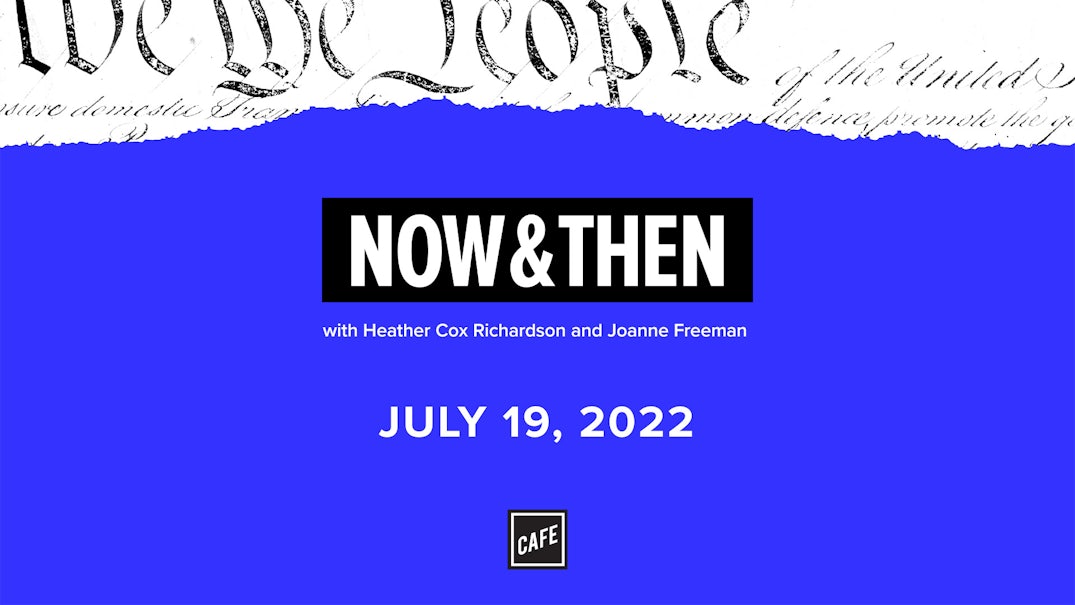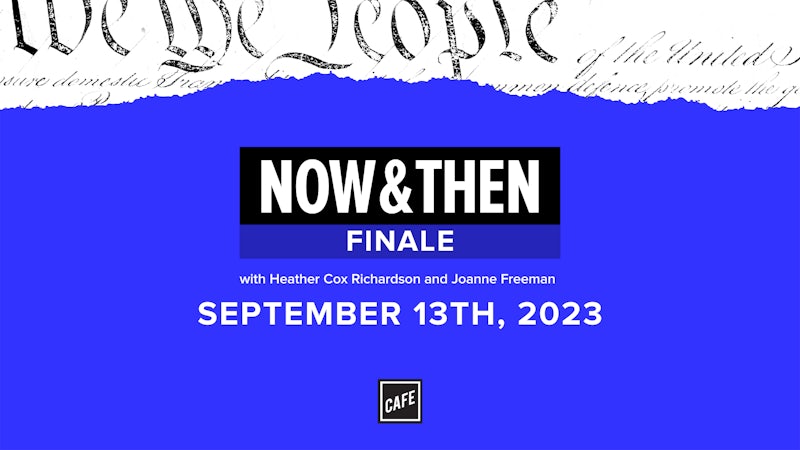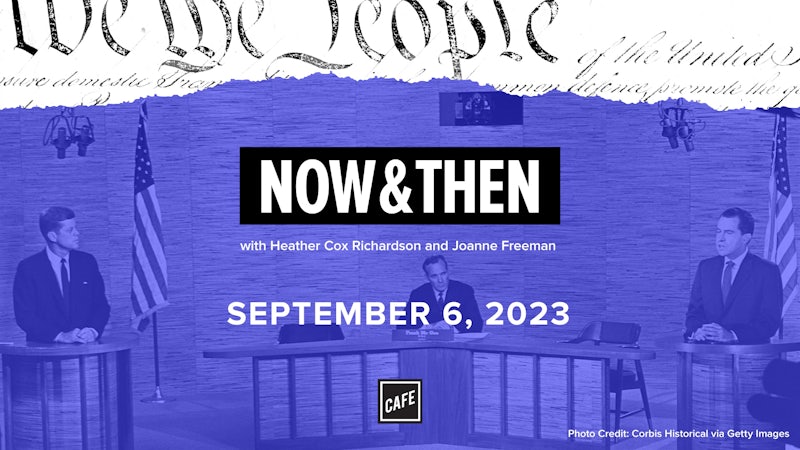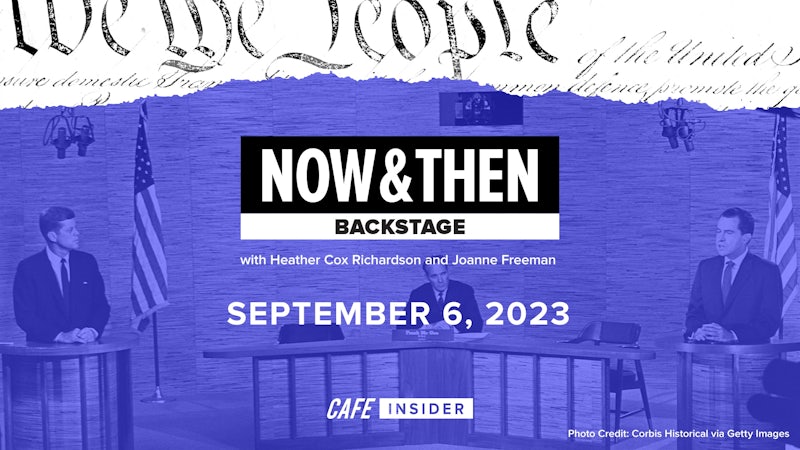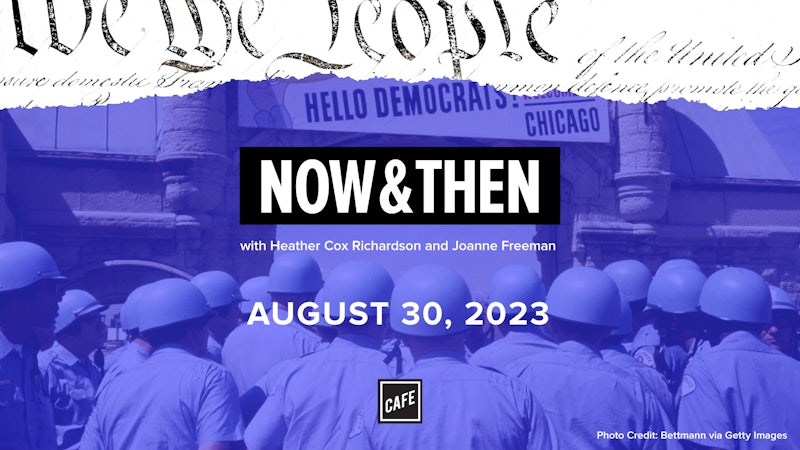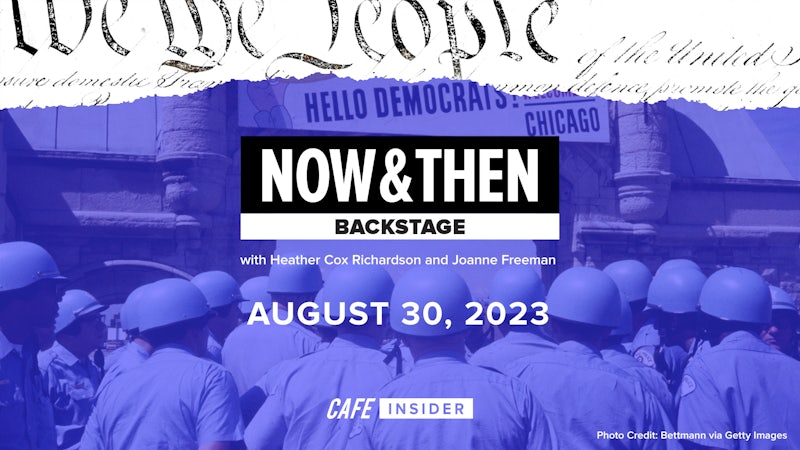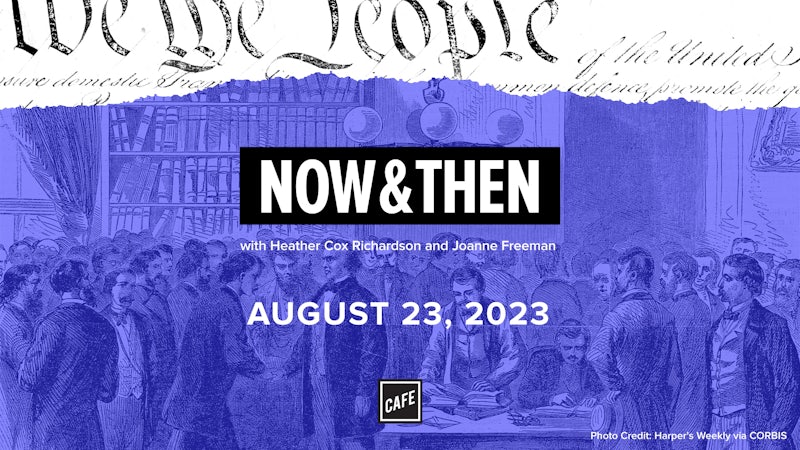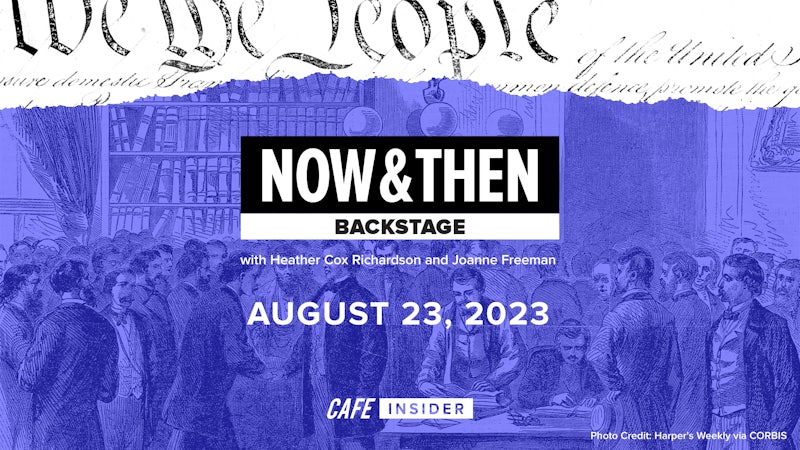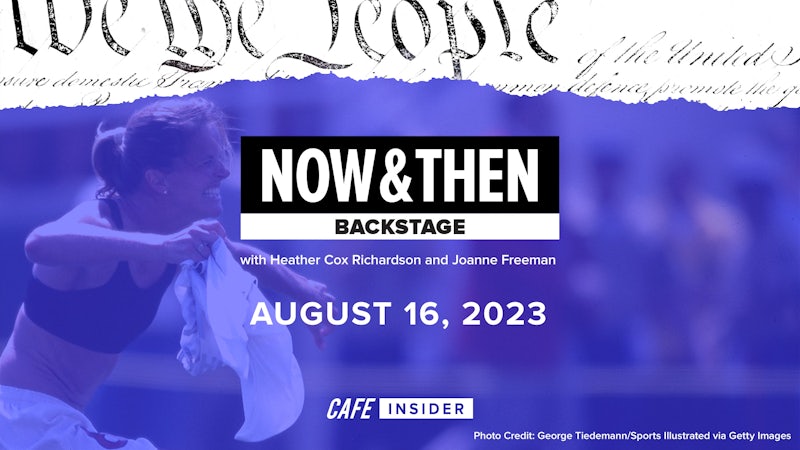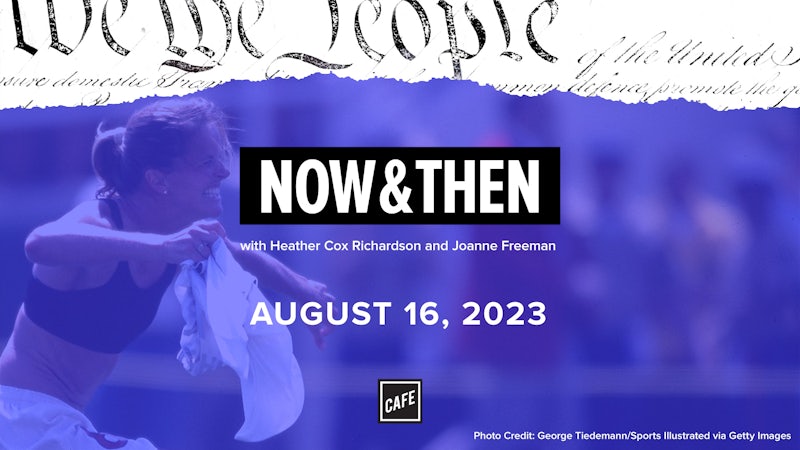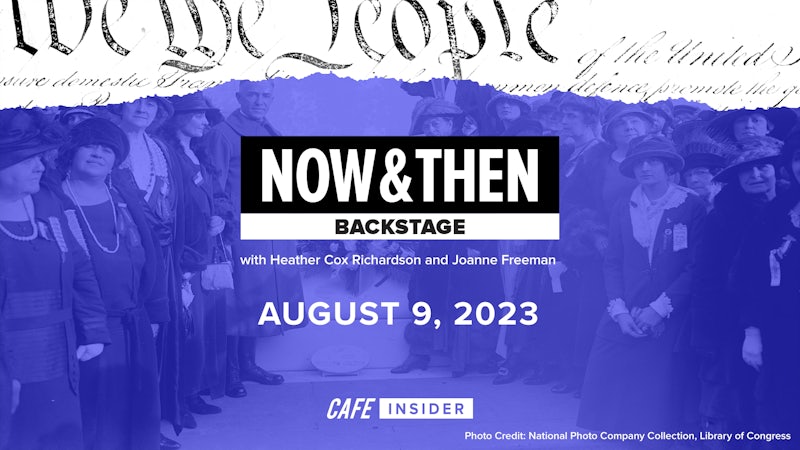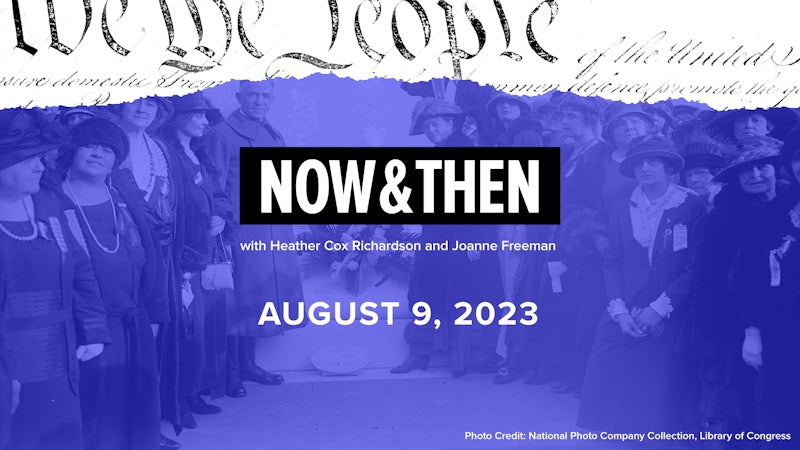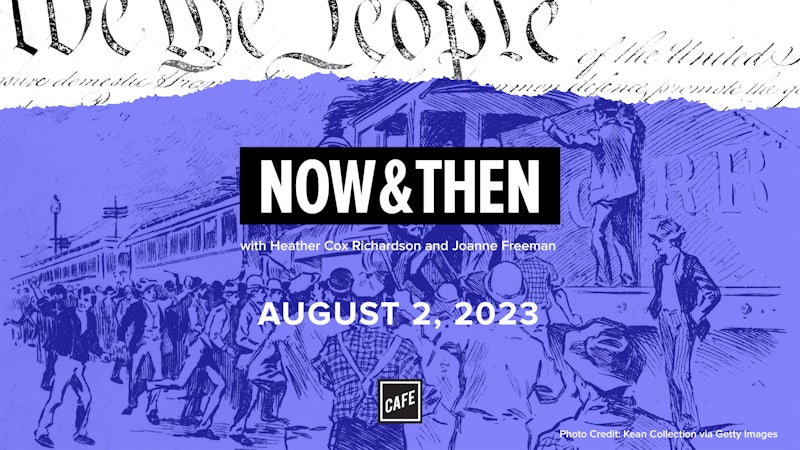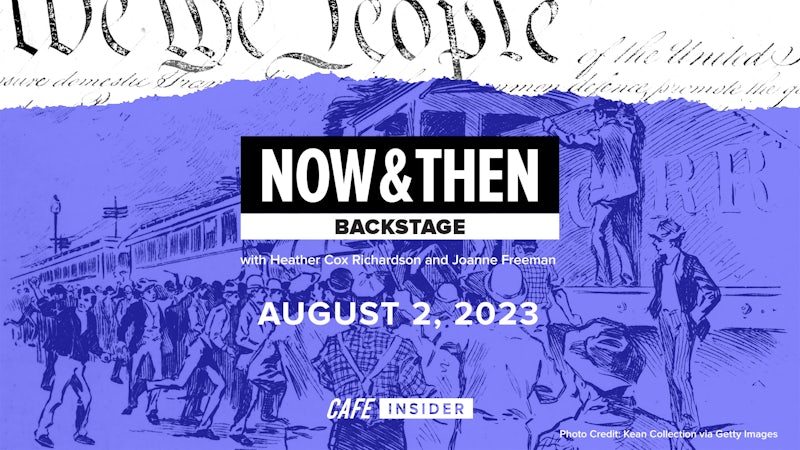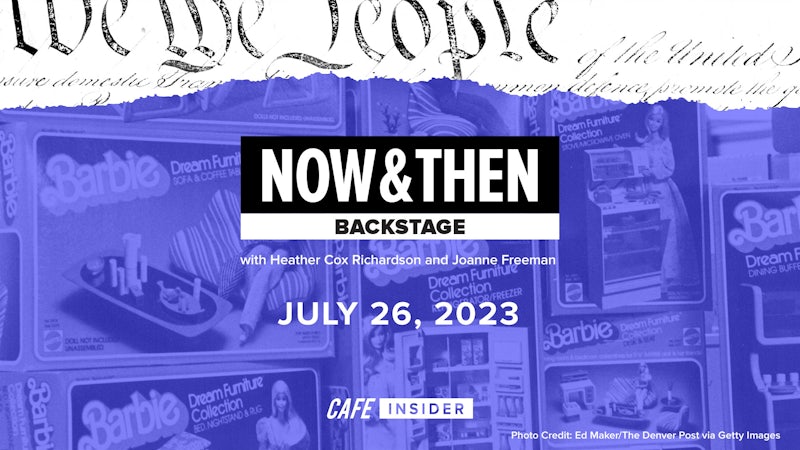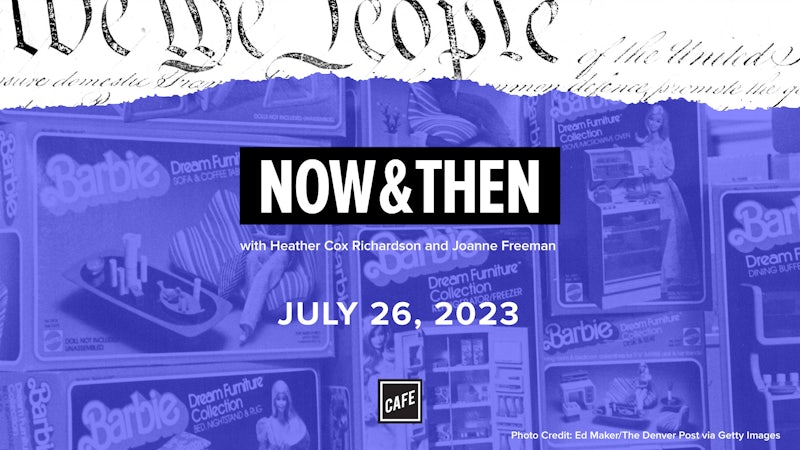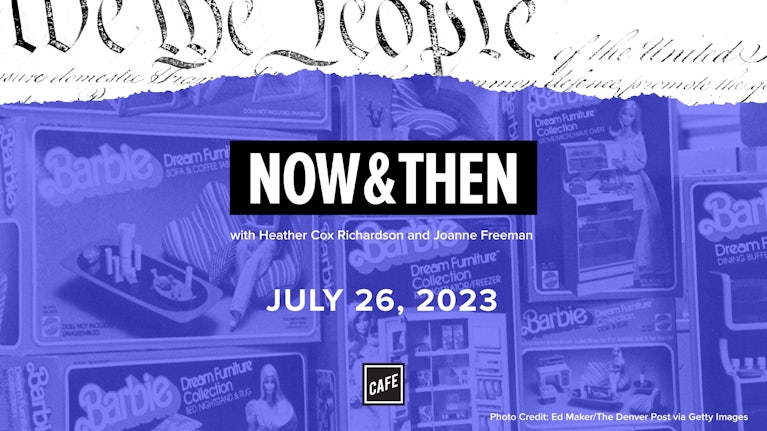Heather Cox Richardson:
From CAFÉ and the Vox Media Podcast Network, this is Now & Then. I’m Heather Cox Richardson.
Joanne Freeman:
And I’m Joanne Freeman. Today we’re going to talk about a topic that grew from this past week’s January 6th hearing that focused, among other things, on various militia groups like the Proud Boys and the Oath Keepers, how they were involved in the events of January 6th, and what their relationship was with former President Trump and the Trump administration.
And because of that, and because of the many ways in which in one way or another militia groups have been in the news in even just recent years, that’s what we thought we would focus on today. We would talk about some of the tradition behind militias in American history, where they started, how understandings of them have changed over time, and the ways in which there’s a lot of fuzziness around what a militia actually is and ways in which that shapes what they can and can’t do.
Heather Cox Richardson:
We actually wanted to talk about what a militia actually is and what the origins of that term are and how it has played out through a number of critical eras in American history. I also like this topic because it gets me once again the chance to talk to Joanne about things that we all want to know, and that it’s really hard to turn to the person next to you on the subway and say, “Hey. What do you know about militias?” So now is my great opportunity. Tell us if you would, what the heck a militia is.
Joanne Freeman:
Militia is partly tied to what becomes a larger American tradition of the military and government and national security and national defense. I’m sure when I say the phrase Yeoman farmers, some people out there are thinking, sorry about this Heather, Thomas Jefferson, but he is one person who had this image-
Heather Cox Richardson:
Oh. Come on. He did not organize a militia and be part of it, did he?
Joanne Freeman:
No. He did not, but I love your facial expression.
Heather Cox Richardson:
Yeah. I was like, “There’s no freaking way he was out there carrying a musket.”
Joanne Freeman:
No. But he had this idealized vision that the way that American military defense would work is that you would have all of these independent farmers out working on their farms, and they would be able to rise up and run to defend their land and the country when needed. And then when the warfare was over, they would just go back to their independent farms.
Heather Cox Richardson:
Citizen soldiers.
Joanne Freeman:
Precisely. And that’s a tradition that bleeds into how people understand what a militia is. I’m sorry. I didn’t mean that pun at all. But again, your facial expression was painful there.
Heather Cox Richardson:
Well, I’m sorry. I’m back a little bit on this because the whole concept of citizen soldier that comes out of this era is so bizarre in so many ways. And I think we still labor under the delusion that people can pick up a gun today and march out and come back wounded in whatever ways they are, and then put the gun down, and then suddenly become farmers again, and everything’s just A-okay. And it’s never been that way. To hear that this is the ideal from early on is crap. We’ve been at this a while.
Joanne Freeman:
Right. When you had colonies and not states and no real national government, it was a slightly different story. But part of the story of the first 10 years of the government is Americans were really nervous about the idea of a standing army. They didn’t like the whole idea because a standing army was a tool of tyranny and a president or a tyrant could take the army and seize the government and use power that way. Or an army itself could rise up and attack the government, or a standing army would cause all kinds of taxes and expenditures, and people in power who would keep themselves in power by playing around with standing armies. So that’s a big, big no-no for many people in this time period.
And again, militias are an alternative to what people would’ve seen as a standing army. It’s not a standing army. It’s basically local units of men, able-bodied men who get together to drill and be in a state of preparedness if their services are required on a local level. And so for example, during the Revolution, you have on the one hand, the Continental Army, which is an army. You also have all of these colonial and then state militia units joining in the fight as well. So in the Revolution, you actually have an army and militia joining in that fight.
Heather Cox Richardson:
So I have a question for you about that. It is my understanding of militias that they were ragtag and messy, and that Militia Day, Muster Days, as they were called, were usually characterized by drinking and screwing around, playing games and all that sort of thing. So I was thinking about that when you were just talking about the idea of having militias because they’re not going to become a standing army. They’re cheaper than having to pay for a standing army, and of course, that’s going to cause a problem for the colonial leaders during the Revolutionary War. Is that where we get the idea of a well-regulated militia in the Second Amendment, that they don’t just want guys to show up with a pint of beer and a gun, they actually want them to have drilled and have some sense of how to actually fight?
Joanne Freeman:
Yeah. Well, and they did drill. I mean, these musters, they weren’t models of discipline, but the reason they happened was because they were considered a kind of drill. And people would get together and drill so that they would actually be prepared to be in some state of regulation if their services were required.
Heather Cox Richardson:
But is that what’s behind well-regulated militia, not just you can have people popping up from behind rocks, but we actually want you to train them?
Joanne Freeman:
Well, I don’t know if well-regulated necessarily means trained. That sounds more formal to me maybe than where I would go for this. Well-regulated meaning orderly and informed and knowing how to do what they’re doing and not out-of-control, flaming gun carriers. Basically, well-regulated militia is a way of referring to a group that in some way or another has to act as a group to do a service.
Heather Cox Richardson:
Well, in this era, they do that a lot with stuff. You repair roads as a team, too. You have to show up for a certain number of days or weeks, a year to fix the roads. And you might not know anything about building roads, but you’re just supposed to show up because it’s a community. That’s how you’re supposed to do it.
Joanne Freeman:
There’s an example for me, a local example of what we’re talking about when we’re talking about regulated militia and what they’re doing, in New Haven during the Revolution, when it was whispered about that the British might be coming near New Haven, a group of local people created a militia amongst themselves and would routinely get together and drill. And by that, all I mean is figure out how to march. There was one guy who would practice in his yard the right kind of horsemanship so that he could use his horse in the right way if there actually happened to be military action. So this was just a group of people who were afraid of what would happen, and they decided, again, able-bodied men, to get together and organize themselves in case they were needed. That’s the kind of spirit behind some of these early militias.
Heather Cox Richardson:
Okay. So we’ve got these guys organizing in the colonial era. Then what happens?
Joanne Freeman:
First of all, you have the Revolution. And the Revolution in one way or another empowers lots of different kinds of people. It empowers American civilians and women and African Americans to have a sense that, “Hey. I can fight and I can do things and be a political citizen in some way. Well, the militias also have a sense of being a unit and taking part in a fight that ultimately does give them some kind of a sense of entitlement, that they’re entitled to the benefits of the Revolution like anyone else. During the Revolution, you had a lot of spirit like, “We’re all in this together.” And the unfortunate truth of the 1780s, which ultimately leads to the Constitutional Convention, is that when there wasn’t a war, all the states just drifted apart. People weren’t connected together really in any way. They were focused on local business. And then you get an event that has to do with indebtedness and farmers. It starts in Western Massachusetts. It spreads a little bit beyond.
So basically the economics of that region are bad in this time period. There are people being sent to debtor’s prison. And then in early 1786 with the depression getting worse, the Massachusetts state legislature passes some particularly high poll and property taxes. So for example, in 1774, taxes had been 15 cents per capita. By 1786, they were up to $1.75, which was a big increase. So farmers began to organize because this was a lot of money. People were being imprisoned for it. This was a serious, immediate problem. And by the summer of 1786, there were farmer advocacy groups that were arguing for reforms, arguing for lower property taxes, arguing about taxation, even arguing for the abolition of the state Senate in Massachusetts. By August 1786, the calls became more violent.
Heather Cox Richardson:
And they asked the legislature to lower the taxes. And the legislature takes a look and they say, “No. Sorry, we’re keeping the taxes.” And the people out west say, “Well, wait a minute. This government doesn’t represent us any longer, and we’re totally okay with that.”
Joanne Freeman:
“This is another one of those things you do. Yeah, Heather. We’re totally okay with it.” No. What’s interesting about that too, is you look at the pattern over the period of the American Revolution, and the colonies first do the formal, official thing like, “We’re going to send a petition to Parliament. We’re going to send a petition to the king.” And it’s after that fails that they begin to resort to more violent and ultimately rebellious action. So in a sense, some of what’s happening here is following that tradition. We’re going to try doing something in a more formal way. “Oh, yes. They’re ignoring us. So now we’re going to have to do something else.”
Now in walks Daniel Shays, who’s a farmer in Pelham, Massachusetts. He had been a captain in the Revolutionary War. Apparently he fought at Bunker Hill and Ticonderoga and Saratoga. He had even organized a voluntary militia. So by 1786, he had been sued for $12 debt and had been forced to sell the ceremonial sword that he had been given by the Marquis de Lafayette, which is… Your face expresses exactly what I feel when I say that. It’s like, how can you not go, “Oh, man.”
So he begins organizing farmers to march on the courthouse in Northampton, Massachusetts. And on August 29th, 1786, he joins about 1,500 farmers and they occupy the court. They try and close down the court and they begin doing that in other counties as well. Now what happens at that point is on September 5th, the Massachusetts governor tries to raise a militia to fend off these rebels. But the problem is that a lot of the people who would’ve been militia men guarding, fending off the Shaysites actually like Shaysites. They kind of agree with that cause.
So it becomes almost impossible for the militia to be called to fend off and shut down this closing of the courts and these angry massing farmers who are demanding their rights. And in the end in Shays’ rebellion, there ends up being a privately funded militia of sorts in Massachusetts that is called in to stop Shays’ rebellion. So a privately funded militia, because they can’t find any other way to do it. They even asked the Confederation Congress for assistance, Massachusetts, and the Congress essentially says, “This is a Massachusetts problem.” So Benjamin Lincoln, who had been a general during the Revolutionary War and now was commander of the Massachusetts state forces, basically took control and planned to create a private militia to put down the insurrection. And he essentially went and asked wealthy people in the community, about 130 of Boston’s wealthiest citizens, to give donations to pay for this private army to put down the insurrection, and the governor gave a contribution to.
So, in late January of 1787, Lincoln and his private militia take up a position between two rebel groups, one led by Shays near Springfield. And on February 3rd, 1787, Lincoln marches his men, apparently during a blinding snowstorm, if you need to picture this, to cut off Shays’ troops. And 150 surrender, the resistance is quashed, and Shays fleas. But the important thing to realize about this is what struck onlookers, and particularly politically-minded onlookers, was that there had been an attack on the courts, an insurrection that couldn’t be suppressed in any way, and it was suppressed ultimately by private money. For people who were worried that the national government wasn’t strong enough for the new nation and were worried that everything was going to spin out of control because there was nothing really joining the states together, Shays’ rebellion to them was terror.
It was like, “Look at what’s happening. This is what we’re up for. Without a stronger government than the Articles of Confederation,” which is what they were under at the time, “we’re going to have all of these little rebellions and insurrections and each state will want help from the Confederation Congress. And Congress won’t want to fund them and it’ll be chaos. It’ll be out of control. We need to strengthen the government.” So when you look at letters between people like Washington and Hamilton and others who went through the Revolution at headquarters and could see the ways in which the Continental Congress didn’t organize a war very well, Shays’ rebellion is the last push that tells them that they have to make the national government stronger.
Heather Cox Richardson:
So this raises a lot of the distinctions that you and I were talking about between the idea of a militia that represents the people and a militia that also challenges the government. But I just have to say the reason I care so much about Shays is because when I used to work at UMass Amherst, I drove down Shays Highway every day when I went to work. And there’s a big Boulder beside the road where at least once a year, I would stop and read the marker on it, and saying that that marked one of the places that they had marched by in order to march on Boston. That part of Western Massachusetts, first of all, nowadays people jokingly call it the Happy Valley, but it’s the Connecticut River Valley. And the wind whips through there like nothing I’ve ever seen aside from the buildings in Chicago.
So you think of these guys out there, and it feels like a gazillion miles from Boston. And the fact that they couldn’t get relief from Boston and nobody paid attention to them, and they really felt like they were the ones who won the government in the first place, and now their land was being taken away from them, and their ceremonial sword presented by Lafayette is getting taken away. But you can really feel just how desperate these men and angry these men were.
Joanne Freeman:
That’s what I was going to say. The sense of betrayal, right?
Heather Cox Richardson:
Betrayed. Exactly.
Joanne Freeman:
That they’d gotten through the Revolution. They had done what they’d done, worked for what they worked for. And now they were being punished and they felt entitled to some kind of security or independence, and it was being taken from them, and they had no way to secure it other than this. But yeah. You can sense their betrayal and their anger. And you can sense the kind of power they felt that they had coming together in a group like that.
There’s a letter I once found. A Yale student traveling north back down to Yale apparently temporarily was held by some Shays rebels just because they didn’t know who he was and they just stopped him. And then he was allowed to go on his way and he got to Yale and he was interrogated like, “What did you see? What did the Shaysites say?” And the information was passed along to government officials. So the part that struck me was just that he was held by them and then released by them. And everyone was like, “Tell us. Tell us what it was like.” The larger point here is that people knew very much what was going on in Massachusetts. They knew about Shays’ rebellion outside of Massachusetts and they knew about the implications of it and what it suggested about the government and insurrection and power and control and issues that hadn’t been decided yet about what kind of government was going to be governing the new nation.
Heather Cox Richardson:
You can receive the Time Machine articles through the free Cafe brief email. Sign up at cafe.com/brief. So the late 19th century is a really cool moment for American militias for a couple of reasons. The first is that coming out of the Civil War, people are much less inclined to organize as militias because they’ve just been through a war. And in fact, you remember that one of the reasons we get the NRA is that the organizers of the NRA are concerned that people are not using their guns anymore and they’re not learning how to shoot the way they should be able to. And they’re concerned that people are not being as involved in the potential to become warriors again, as they ought to be. So at first, there really isn’t much of a move toward militia. And what happens instead is that nobody quite knows what to do with the US Army, which all of a sudden is huge or has been huge, even though they’re cutting down the size of it.
And it becomes deployed after the Civil War not only against the indigenous Americans in the American west, but it begins to be deployed against strikers. And really dramatically, in 1877, strikers begin to protest wage cuts on the B&O Railroad, the Baltimore and Ohio Railroad. And when they did that, they prevented trains from crossing the place where they were striking and from going from there all over the country. And when that happened, eventually the president, who’s Rutherford B. Hayes at this point, calls out the military. He actually calls out the Army to break the strike. And this horrify a lot of people, and it doesn’t help that the railroad lobbyists, led by Thomas A. Scott, who’s one of the big railroad men in the country, were instrumental in making sure that the three Southern states that had competing slates of electors in the 1876 election, he’d been one of the people who had convinced Southern railroad leaders to get behind the election of Rutherford B. Hayes. And here they are just months later. Those same railroad barons are calling the US Army to put down the strikers.
So this confluence of the idea that somehow there was put into the White House a man who was beholden to the railroad man, and then just months later, who’s using the Army to defend their interests, really horrifies the Democrats who take control of Congress and go ahead and put together the Posse Comitatus Act. And this is one of my favorite acts in American history because the-
Joanne Freeman:
I have to say that I know this because when we started talking about this episode, the first thing out of your mouth was this.
Heather Cox Richardson:
Was Posse Comitatus, was it?
Joanne Freeman:
Posse Comitatus Act. I was like, “Okay. We’re going for it, Heather.”
Heather Cox Richardson:
I love the Posse Comitatus Act because there are so many repercussions of this. It’s such a moment that illuminates the 1870s, and there are so many repercussions for it. What Posse Comitatus says is that the US Army cannot be used against US citizens. Just think about that right there. A president cannot use the Army against US citizens. What that says is they’re concerned about a president getting so much power that he will use the Army against American citizens. And they get it through Congress, and that’s going to change the way we think about militias. But I just have to say that one of the reasons Posse Comitatus has always fascinated me is that I learned most about Posse Comitatus when I was writing about indigenous Americans because one of the things they just don’t discuss in Congress when they’re thinking about it is the fact that who is protecting the indigenous Americans on the reservations from white guys crossing into the reservations and taking their horses, for example? And the answer is the US Army.
So Posse Comitatus, which is supposed to protect American citizens, quite explicitly basically screws over the indigenous Americans because they can’t rely on US Army protection any longer against white vigilantes, for example. And that’s one of the reasons we’re going to get the rise later on of indigenous police forces on the reservations, because they can arrest US citizens.
Joanne Freeman:
They need essentially the equivalent of a militia.
Heather Cox Richardson:
Exactly. So with Posse Comitatus, there’s to my mind going to be two splits in the way we think about the militia. I guess in some ways they’re both for runners of the present. But one that is really interesting is the rise of posses. Posses, right?
Joanne Freeman:
Western movies. People must have heard the word posse before.
Heather Cox Richardson:
They’re famous because of the west. But what a posse was is the same impulse as the white southerners were using when they were lynching their black neighbors. It was a reflection of the fact that they did not trust the government in place, and therefore, they were going to take matters into their own hands, which is the way they justified, for example, dragging people out of prisons and lynching them because what they said is, “We can’t let them be taken to trial because everyone’s corrupt and they’re not going to come out with the right answer.”
And this happens again across the country, but there’s a wonderful moment in Owen Wister’s book, The Virginian, where the young woman involved and the love interest in the story, Molly Wood, is upset because the Virginian is on his way out to… I’m sorry, this is a spoiler, but he’s on his way out to hang a horse thief. And she’s like, “Oh. They shouldn’t do this.” And there’s a guy who’s a judge who sits her down and says, “No, you don’t understand. This isn’t like in the south where white gangs string up their black neighbors, which is lawlessness.” He says, “This is because we want to have law, and this is us taking matters into our own hands to give ourselves law.”
Joanne Freeman:
Talk about that slippery line, the amorphousness of this. It’s like, “But they’re doing it in a bad way and we are doing it in a good way. And when they do it, it’s lawlessness. When we do it, we’re defending law.”
Heather Cox Richardson:
Yes. And that is exactly how that moment jumps out. Anyway, so that’s one thing that happens is this whole idea of people taking matters into their own hands and justifying it in the west, for example. And of course, white southerners justified it with similar language, and northerners who did the same thing in places like Cincinnati justified it with the exact same kind of language. But what really interests me in the late 19th century is a very different militia that has largely been forgotten, I think, in American history. And everything I know about it comes from a dissertation that came out of Brandeis by Yoni Appelbaum a number of years ago in which he was looking at fraternal organizations in the late 19th century. And I do not want to speak for him here because my take on his work was very different than his. And I think we both agree… At least I thought it was excellent.
What most people don’t realize is that after the Civil War from the 1880s into the 1920s at least, America has this extraordinary flowering of fraternal and sororal organizations. And when I say flowering by that, I mean, people joined fraternal organizations, and lots of them. So on the Eve of the Spanish-American War, for example, a number of fraternal organizations had militias that outnumbered the number of soldiers in the US Army. The Masonic Knights Templar had more than 160,000 members.
Joanne Freeman:
But here’s what’s interesting about that. There’s a similar moment in the late 18th, early 19th century in which there’s the creation of all of these societies and groups, and part of what they do is get together and march around and have uniforms, and there’s a military component to it, but it really falls more into the realm of these fraternal orders as well. It’s really interesting. It’s part of what de Tocqueville was commenting on. When he comes to the United States in the 1830s, he’s like, “Look at all these people. They keep putting themselves in these societies and fraternal organizations and clubs and groups. What is this all about?” And it’s interesting. This is after the Civil War I’m talking about, after the Revolution. It’s interesting to consider what that suggests about the next generation of people and how they’re absorbing the military culture of what just happened.
Heather Cox Richardson:
So yes, and my take on it is that in this period, what they are reacting to and less in the fighting business, less in the walking around with guns thing, is they’re reacting to the fact that this industrial society in which people are moving around a lot more than they have before, there’s no social safety net. So what these fraternal organizations do is they provide care for widows and children and they provide burial insurance, and they provide essentially a charity insurance for people who otherwise are going to be out of luck if they lose an arm or if they die and their widows are left behind. So the militia part of that strikes me as looking much more like the idea of what I think of as the Revolution, the original Revolution, the idea of taking care of each other. So rather than being like, “I’m going to be Teddy Roosevelt out here and go lynch a horse thief,” they’re thinking, “I’m going to join together with people to take care of them.”
Joanne Freeman:
And that’s important because what you’re talking about here is an internally directed group. “We’re going to create a group and take care of ourselves,” versus I think what most people think a militia movement is, is, “We’re going to get together and attack whatever, government or other people.” It gets back to this amorphous understanding of what a militia is, what it can be, the different shapes it can take. And yet when you use that word, it suggests a lot about what it is that you’re saying.
Heather Cox Richardson:
I think your distinction there between getting together to take care of yourselves and getting together to attack somebody else is a really important distinction, but there is also, I think, something you just said that matters, and that is this is not the war generation. It’s the generation after the war. So that’s not to say there weren’t some Civil War veterans in these later fraternal organizations. Of course there were. There were Civil War veterans around in the early 20th century.
Joanne Freeman:
Oh. I don’t even mean veterans. I actually explicitly mean the next generation that is looking back at what happened.
Heather Cox Richardson:
They have the military structure and the military… I mean, I’m going to say playacting, and I’m just going to get angry letters about it, but they are willing to do this and to drill and to march in the streets and all this in a way that their fathers weren’t. Again, in this very same period that I’m talking about, when people tried to convince William McKinley, who was president at the time, to fight against Spain, he said, “I have been in one war and I have seen the bodies piled up, and I do not ever want to go to war again.” Well, the next generation like Teddy Roosevelt is like, “Let’s go to war.” So I think that generational thing matters as well.
Joanne Freeman:
Yes. I totally agree.
Heather Cox Richardson:
Which brings us quite seamlessly… poof… into the modern militia movement.
Joanne Freeman:
Indeed. Now at the peak of the modern militia movement, in 1996, there were an estimated 868 American “patriot” groups, most of them well-armed, most of them formed in one way or another in opposition to what they saw as strong-armed federal law enforcement tactics.
Heather Cox Richardson:
So the modern militia movement allegedly peaks in the middle of the 1990s, which I think really fits. But one of the real sparks to the militia movement comes from the whole, I think, push of the Reagan supporters against the federal government, the idea that the federal government is crushing the small individual man in a way that harkens back to Shays.
Joanne Freeman:
That the government is of them. The government is strong-armed. The government demands what it wants. In a sense, if you go all the way back to where we started with the farmers rising up to defend the country’s rights, this is that same impulse. The government, in a sense, is the enemy. And these militias are rising up to defend what they see as their rights against what they see as this strong-arming national government.
Heather Cox Richardson:
What’s really interesting about that is that to me, it seems like a deliberately constructed, top-down constructed new approach to politics. So one of the key elements in the rise of the modern militia movement is the 1984 movie Red Dawn by John Milius. Red Dawn, when it was made, at the time was the most violent film ever made. And it was the story of a group of high school football players in Colorado, out in the west. They were known as The Wolverines, and they were fighting off a communist invasion. And they had to fight off the invasion because the government, both of the town and at a higher level, was cooperating with the communists.
Reagan’s first secretary of state, Al Haig, was actually an advisor to the film. And it was such a moment of inspiration that a number of young men promptly went out and believed that they too could defend the people in their local areas from these communists who were taking over the American government, which is precisely the sort of language that the people on the far right were using. And this was such an aspect of popular culture, so incredibly popular in 1984, that when the captain in the Army, a man named Jeffrey McMurray, was asked to provide the code name for the operation to capture Saddam Hussein in 2003, he called it operation Red Dawn because he said, “I think all of us in the military have seen Red Dawn.”
Joanne Freeman:
I just want to highlight the impulse that underlies that piece of popular culture and how it went on. The impulse underlying that, of defensive, guttural need to stand up to unfairness, to stand up to the enemy, that heroic but guttural personal way in which this is interpreting coming together in that way to fend something off with military power, it’s a powerful way to grab people. It has a power to it. And it would inspire you, particularly if you were a young man. If you’re believing that there’s an enemy of a certain sort, of course, he would be inspired to act in that way, to find people who are like-minded with you and to stand up against what you see as something that’s threatening and bad.
Heather Cox Richardson:
Yeah. And I hope you were listening to what you just said because there are echoes. All right. So let’s walk through the rest of the modern militia movement because if what you just said could have been transposed to 18 months ago.
Joanne Freeman:
Well yeah. I’m writing about this right now.
Heather Cox Richardson:
Let’s get the path that got us there. So if that’s 1984 and people are thinking along those lines during the Reagan years, anti-communism, the people who have been in control of the country since World War II, our closet communist, they’re spreading communism, all those sorts of themes that have been there since World War II. This whole idea really takes off in the 1990s because first of all, in Ruby Ridge, Idaho in August of 1992, a man named Randy Weaver, who had sold a sawed-off shotgun to an ATF agent, was supposed to show up in court for a trial, and he didn’t go. He didn’t show up. So when that happened, federal marshals tried to arrest him out in Idaho. And he’d moved there because he thought there, he could protect his family from what he saw as the corruption of the modern world.
And in the process of trying to arrest him, there was a firefight in which Weaver’s 14-year-old son and a deputy Marshall were killed. And in the aftermath of that attempt, there was an 11-day standoff between the federal marshals and Weavers, and finally a sniper wounded Weaver and killed his wife, Vicky. And as the standoff was going, the people from the nearby Aryan Nations compound came over and swarmed to Ruby Ridge to protest the government because they said that the government was attacking a man who was protecting his family.
I think it’s important to remind people that he had, in fact, illegally sold a gun and was supposed to show up in court. I mean, he was supposed to do things that he simply refused to do. A lot of times, the mythology says that the government just decided to start shooting him. And that is not actually what happened. The negotiators finally brought Weaver out, but a lot of people looked at what happened at Ruby Ridge and decided that they needed to start arming themselves, especially those people who were susceptible to that language about how the government was attacking individuals.
Joanne Freeman:
Overreach. Government with guns going into people’s homes.
Heather Cox Richardson:
People who study the modern militia movement think that that was really the spark that made it take off. But it really got into overdrive, if you will, the following year, just at the beginning of Bill Clinton’s term. And of course, Bill Clinton was opposed by these same groups because he was a Democrat, because they insisted that the idea of a social safety net, for example, was a form of communism. He had this very similar theme to what played out at Waco when federal officers stormed the compound of a religious cult, and some people had left it, and they had reported to authorities that the leader, a man named David Koresh, was stockpiling weapons and was abusing children. They tried to go in to see about the guns and to see what was happening, if there were in fact children who were at risk in the compound. And that launched a 51-day siege, and that siege ended in a gun battle and a fire in which 76 people died on April 19th, 1993.
And the Republicans do an investigation of what happened at Waco. And the investigation says there is “overwhelming evidence”, that’s a quote, that exonerated the government of doing anything wrong. Nonetheless, remember when this is. This is the Clinton administration, and this is talk radio. This is when talk radio is really hitting the ground after the end of the Fairness Doctrine in 1987 and talk show hosts like Rush Limbaugh and especially Alex Jones, who’s going to go on later to start Infowars, this is where he gets to start. He drops out of community college and he begins to talk about what happened at Waco. And what they do is they talk about the Waco invasion. They talk about the government murdering citizens. They talk about the idea that a group of Christians, that’s what they’re calling David Koresh’s group, had been killed. And the person who was behind that was Attorney General Janet Reno, a woman who looked in their minds mannish, she was not a real woman, and here she was out killing good Christian men because she’s been empowered by the government.
Joanne Freeman:
I want to make a point here only because it’s what struck me. All of these things that talk radio and the rise of people seeing the government as the enemy in this way and the rising of these militia groups, in a modern sense, this is pretty recent. We’re talking about the 1990s. And I think that’s worth remembering. We’re talking about something born very much in the modern era. And in a sense, we’re still in the process of this evolution.
Heather Cox Richardson:
Well, and what’s interesting about that too, is that this doesn’t stop. I mean, it goes from there into Cliven Bundy, the Nevada cattle rancher in 2014 who says he doesn’t recognize the government’s power over the federal land on which he’s been grazing his cattle. That’s going to snowball into one thing after another. And I think you can say it reaches forward into the summer of 2020 with the idea that you have people screaming about liberating Minnesota and liberating Michigan and liberating Virginia from the tyrannical governments that are trying to manage the pandemic. But what is part of that though I think that is interesting in this moment is the co-opting of that earlier idea that it’s a militia that defends the construction of the American government. What you were talking about, that idea of taking care of yourself, it conflates that with the other thing you were mentioning about a militia that attacks other people and says, “We’re the people attacking other people, but we’re the good guys.” So it brings those things together.
Joanne Freeman:
Well, we are protecting ourselves by attacking the other people, that it’s not just we are seeing to ourselves, as some of these militia units did later than where we started this discussion today. But to do that, they have to be aggressive. They have to reach out. They have to in be, in some cases, military. They have to be aggressive fighting units in some way. So no, you’re absolutely right. It’s a mixed message, but it’s a really powerful mixed message.
Heather Cox Richardson:
And it brings us perhaps to the present with the attack on the US capital on January 6th, with the number of people who were trying to destroy our democracy and yelling, “1776.” I mean, Alex Jones at that rally on January 5th, the night before, yelling, “1776. 1776. 1776.” And the crowd yelling it back and constructing this idea that somehow, they were the good guys by destroying our democracy.
Joanne Freeman:
In light of that and in light of the hearing, there’s been a lot of talk going around some people who maybe are more sympathetic towards what happened on January 6th and saying it was an attack on government. It was an attack that shows the long American tradition of pushing back against unjust governments, that governments are bad, that governments are the enemy. And if you look back to the founding generation and you look back to the revolutionaries, particularly 1776, they were fighting against government. This shows that this is a longstanding American tradition.
And my immediate response to that was what was the first thing that colonists did when they declared themselves independent from Britain? They created governments. That’s not a tradition. You’re talking about people engaging in a behavior and doing it in a tradition even at the time that they’re framing it in a way that makes sense to them, that emotionally makes sense to them, that logically makes sense to them. But you have to question the underlying reality of the dynamic that’s going on. So January 6th, you might be claiming, “1776. Look. We’re operating like a real American militia.” But the militia in this early time period and throughout, they were not trying to destroy all government. They were worried about themselves and their own good, but these militias weren’t necessarily against all government, which is I think how some frame what’s going on today.
Heather Cox Richardson:
Well, they remind me of the posses that I mentioned briefly. The reason that the posses feel they need to form in the late 19th century, in the early 20th century, is because they don’t trust the government, because the government is popular. And they will say, “No. In fact, you can’t have all the land for yourself in the west. That the people that you are trying to chase out as being squatters and horse thieves in fact have as much right to the land as you do.” So there is an element there of the attempt to impose the will of the minority through violence. That is not the case in, for example, the militias of the late 19th century. And from the sound of it, even Shays’ rebellion, which wants relief, but it doesn’t want to impose its will on the bankers in the east, does it?
Joanne Freeman:
No. They were upset about taxes and debtor’s prison. And they felt that they couldn’t find a path to get a response, and they attacked the courts, and then it went beyond that. So no, they weren’t reaching out and attacking all government altogether. They were process-driven and they were purpose-driven, goal-driven. It wasn’t a massive, sweeping statement. So it’s not the same thing as some of what we’re seeing today that is claiming the history and heritage of militias over the long arc of American history as justification for what’s going on now. What’s going on now is something different. What’s going on now really has to do with the government, our feelings about the government at a time when national institutions of various kinds are under attack.
Heather Cox Richardson:
So you had used the word terrorism before, which I think fits quite nicely with the late 19th century posses and not with the late 19th century fraternal organizations. So could we make a distinction between terrorism and actual militias that are designed to create a community of safety?
Joanne Freeman:
A community of safety for the people in it. The first use of terrorism that I came across in my work is used when John Adams is in retirement, but he’s referring to 1798. Thomas Jefferson says something about, “Oh, yes. The 1790s and everything was wonderful and swimming, and yes, the people.” And he was being Jeffersonian. And Adams essentially says, “Really? Is that really how you remember it? Because what I remember from when I was president was people running around in the street, angry at the government because we weren’t supporting the French Revolution. And they were armed, and my servants armed themselves. You know what I call that, Mr. Jefferson? I call that terrorism,” which is a really striking statement to see. And what he’s talking about is people rising up violently against the government. That’s what Adams… That’s at least how he described it.
Heather Cox Richardson:
I am really struck by that because it sounds to me like he is reaching for what was known as the terror, right-
Joanne Freeman:
Correct.
Heather Cox Richardson:
… in French. And I’ve always thought about what happened to Black Americans after the Civil War as terrorism, although they’re not really using that term as extensively in that period as I would today. But if we’re correct and what we’re saying is there is this distinction, it seems like there would be room in today’s America for people to organize at least an ideological militia to reclaim the actual concepts of American democracies. So if that were the case, what do you think? Should you and I organize a militia?
Joanne Freeman:
Wow. I’m not going to answer that in public. But what I will say is that suggestion gets us back to where we started and where we are now. And that is the blurry amorphous way in which we can define militia, and that we have defined it throughout the show. It’s internal. It’s external. It’s organized. It’s not organized. It’s anti-government. It’s anti-communist. There are any number of ways in which you can identify and define this movement. We’re in the middle of one. It’s not as though this is a discussion that has ended. We’re in the middle of a moment where we’re looking at militias, these militia units, and what they do, and how they’re used. The very fact that it is so amorphous and you have to figure out what it is they’re doing and why they’re doing it, that really highlights the way in which we really need to be watching what’s happening in this moment. We really need to understand not just what these groups are doing, but why they’re doing it and how they’re justifying it and how it makes sense to them.












